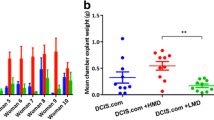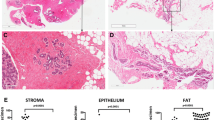Abstract
Mammographic density (MD) is a strong risk factor for breast cancer. It is altered by exogenous endocrine treatments, including hormone replacement therapy and Tamoxifen. Such agents also modify breast cancer (BC) risk. However, the biomolecular basis of how systemic endocrine therapy modifies MD and MD-associated BC risk is poorly understood. This study aims to determine whether our xenograft biochamber model can be used to study the effectiveness of therapies aimed at modulating MD, by examine the effects of Tamoxifen and oestrogen on histologic and radiographic changes in high and low MD tissues maintained within the biochamber model. High and low MD human tissues were precisely sampled under radiographic guidance from prophylactic mastectomy fresh specimens of high-risk women, then inserted into separate vascularized murine biochambers. The murine hosts were concurrently implanted with Tamoxifen, oestrogen or placebo pellets, and the high and low MD biochamber tissues maintained in the murine host environment for 3 months, before the high and low MD biochamber tissues were harvested for histologic and radiographic analyses. The radiographic density of high MD tissue maintained in murine biochambers was decreased in Tamoxifen-treated mice compared to oestrogen-treated mice (p = 0.02). Tamoxifen treatment of high MD tissue in SCID mice led to a decrease in stromal (p = 0.009), and an increase in adipose (p = 0.023) percent areas, compared to placebo-treated mice. No histologic or radiographic differences were observed in low MD biochamber tissue with any treatment. High MD biochamber tissues maintained in mice implanted with Tamoxifen, oestrogen or placebo pellets had dynamic and measurable histologic compositional and radiographic changes. This further validates the dynamic nature of the MD xenograft model, and suggests the biochamber model may be useful for assessing the underlying molecular pathways of Tamoxifen-reduced MD, and in testing of other pharmacologic interventions in a preclinical model of high MD.











Similar content being viewed by others
References
Boyd NF, Guo H, Martin LJ, Sun L, Stone J, Fishell E, Jong RA, Hislop G, Chiarelli A, Minkin S, Yaffe MJ (2007) Mammographic density and the risk and detection of breast cancer. N Engl J Med 356(3):227–236. doi:10.1056/NEJMoa062790
McCormack VA, dos Santos Silva I (2006) Breast density and parenchymal patterns as markers of breast cancer risk: a meta-analysis. Cancer Epidemiol Biomark Prev 15(6):1159–1169. doi:10.1158/1055-9965.EPI-06-0034
Cuzick J, Forbes J, Edwards R, Baum M, Cawthorn S, Coates A, Hamed A, Howell A, Powles T, investigators I (2002) First results from the International Breast Cancer Intervention Study (IBIS-I): a randomised prevention trial. Lancet 360(9336):817–824
Phillips KA, Milne RL, Rookus MA, Daly MB, Antoniou AC, Peock S, Frost D, Easton DF, Ellis S, Friedlander ML, Buys SS, Andrieu N, Nogues C, Stoppa-Lyonnet D, Bonadona V, Pujol P, McLachlan SA, John EM, Hooning MJ, Seynaeve C, Tollenaar RA, Goldgar DE, Terry MB, Caldes T, Weideman PC, Andrulis IL, Singer CF, Birch K, Simard J, Southey MC, Olsson HL, Jakubowska A, Olah E, Gerdes AM, Foretova L, Hopper JL (2013) Tamoxifen and risk of contralateral breast cancer for BRCA1 and BRCA2 mutation carriers. J Clin Oncol 31(25):3091–3099. doi:10.1200/JCO.2012.47.8313
Cuzick J, Warwick J, Pinney E, Duffy SW, Cawthorn S, Howell A, Forbes JF, Warren RM (2011) Tamoxifen-induced reduction in mammographic density and breast cancer risk reduction: a nested case–control study. J Natl Cancer Inst 103(9):744–752. doi:10.1093/jnci/djr079
Li J, Humphreys K, Eriksson L, Edgren G, Czene K, Hall P (2013) Mammographic density reduction is a prognostic marker of response to adjuvant tamoxifen therapy in postmenopausal patients with breast cancer. J Clin Oncol 31(18):2249–2256. doi:10.1200/JCO.2012.44.5015
Ursin G, Palla SL, Reboussin BA, Slone S, Wasilauskas C, Pike MC, Greendale GA (2004) Post-treatment change in serum estrone predicts mammographic percent density changes in women who received combination estrogen and progestin in the Postmenopausal Estrogen/Progestin Interventions (PEPI) Trial. J Clin Oncol 22(14):2842–2848. doi:10.1200/JCO.2004.03.120
Rossouw JE, Anderson GL, Prentice RL, LaCroix AZ, Kooperberg C, Stefanick ML, Jackson RD, Beresford SA, Howard BV, Johnson KC, Kotchen JM, Ockene J (2002) Risks and benefits of estrogen plus progestin in healthy postmenopausal women: principal results From the Women’s Health Initiative randomized controlled trial. JAMA 288(3):321–333.
Chew GL, Huang D, Lin SJ, Huo C, Blick T, Henderson MA, Hill P, Cawson J, Morrison WA, Campbell IG, Hopper JL, Southey MC, Haviv I, Thompson EW (2012) High and low mammographic density human breast tissues maintain histological differential in murine tissue engineering chambers. Breast Cancer Res Treat 135(1):177–187. doi:10.1007/s10549-012-2128-z
Chew GL, Huang D, Huo CW, Blick T, Hill P, Cawson J, Frazer H, Southey MC, Hopper J, Henderson M, Haviv I, Thompson EW (2013) Dynamic changes in high and low mammographic density human breast tissues maintained in murine tissue engineering chambers during various murine peripartum states and over time. Breast Cancer Res Treat 140:285–297
Lin SJ, Cawson J, Hill P, Haviv I, Jenkins M, Hopper JL, Southey MC, Campbell IG, Thompson EW (2011) Image-guided sampling reveals increased stroma and lower glandular complexity in mammographically dense breast tissue. Breast Cancer Res Treat 128(2):505–516. doi:10.1007/s10549-011-1346-0
Arteaga CL, Koli KM, Dugger TC, Clarke R (1999) Reversal of tamoxifen resistance of human breast carcinomas in vivo by neutralizing antibodies to transforming growth factor-beta. J Natl Cancer Inst 91(1):46–53
Curran EM, Tassell AH, Judy BM, Nowicki B, Montgomery-Rice V, Estes DM, Nowicki S (2007) Estrogen increases menopausal host susceptibility to experimental ascending urinary-tract infection. J Infect Dis 195(5):680–683. doi:10.1086/511275
Stillaert F, Findlay M, Palmer J, Idrizi R, Cheang S, Messina A, Abberton K, Morrison W, Thompson EW (2007) Host rather than graft origin of Matrigel-induced adipose tissue in the murine tissue-engineering chamber. Tissue Eng 13(9):2291–2300. doi:10.1089/ten.2006.0382
Love RR (1989) Tamoxifen therapy in primary breast cancer: biology, efficacy, and side effects. J Clin Oncol 7(6):803–815
Provenzano PP, Inman DR, Eliceiri KW, Knittel JG, Yan L, Rueden CT, White JG, Keely PJ (2008) Collagen density promotes mammary tumor initiation and progression. BMC Med 6:11. doi:10.1186/1741-7015-6-11
Lyons TR, O’Brien J, Borges VF, Conklin MW, Keely PJ, Eliceiri KW, Marusyk A, Tan AC, Schedin P (2011) Postpartum mammary gland involution drives progression of ductal carcinoma in situ through collagen and COX-2. Nat Med 17(9):1109–1115. doi:10.1038/nm.2416
Provenzano PP, Inman DR, Eliceiri KW, Keely PJ (2009) Matrix density-induced mechanoregulation of breast cell phenotype, signaling and gene expression through a FAK–ERK linkage. Oncogene 28(49):4326–4343. doi:10.1038/onc.2009.299
Butcher DT, Alliston T, Weaver VM (2009) A tense situation: forcing tumour progression. Nat Rev Cancer 9(2):108–122
Robinson SP, Langan-Fahey SM, Jordan VC (1989) Implications of tamoxifen metabolism in the athymic mouse for the study of antitumor effects upon human breast cancer xenografts. Eur J Cancer Clin Oncol 25(12):1769–1776
Kristensen CA, Hamberg LM, Hunter GJ, Roberge S, Kierstead D, Wolf GL, Jain RK (1999) Changes in vascularization of human breast cancer xenografts responding to antiestrogen therapy. Neoplasia 1(6):518–525
Kyprianou N, English HF, Davidson NE, Isaacs JT (1991) Programmed cell death during regression of the MCF-7 human breast cancer following estrogen ablation. Cancer Res 51(1):162–166
Wolf DM, Jordan VC (1994) Characterization of tamoxifen stimulated MCF-7 tumor variants grown in athymic mice. Breast Cancer Res Treat 31(1):117–127
Hattar R, Maller O, McDaniel S, Hansen KC, Hedman KJ, Lyons TR, Lucia S, Wilson RS Jr, Schedin P (2009) Tamoxifen induces pleiotrophic changes in mammary stroma resulting in extracellular matrix that suppresses transformed phenotypes. Breast Cancer Res 11(1):R5. doi:10.1186/bcr2220
Kim NN, Stankovic M, Armagan A, Cushman TT, Goldstein I, Traish AM (2006) Effects of tamoxifen on vaginal blood flow and epithelial morphology in the rat. BMC Women’s Health 6:14. doi:10.1186/1472-6874-6-14
Ross RK, Paganini-Hill A, Wan PC, Pike MC (2000) Effect of hormone replacement therapy on breast cancer risk: estrogen versus estrogen plus progestin. J Natl Cancer Inst 92(4):328–332
Weiss LK, Burkman RT, Cushing-Haugen KL, Voigt LF, Simon MS, Daling JR, Norman SA, Bernstein L, Ursin G, Marchbanks PA, Strom BL, Berlin JA, Weber AL, Doody DR, Wingo PA, McDonald JA, Malone KE, Folger SG, Spirtas R (2002) Hormone replacement therapy regimens and breast cancer risk(1). Obstet Gynecol 100(6):1148–1158
Reeves GK, Beral V, Green J, Gathani T, Bull D (2006) Hormonal therapy for menopause and breast-cancer risk by histological type: a cohort study and meta-analysis. Lancet Oncol 7(11):910–918
Greendale GA, Reboussin BA, Slone S, Wasilauskas C, Pike MC, Ursin G (2003) Postmenopausal hormone therapy and change in mammographic density. J Natl Cancer Inst 95(1):30–37
McTiernan A, Chlebowski RT, Martin C, Peck JD, Aragaki A, Pisano ED, Wang CY, Johnson KC, Manson JE, Wallace RB, Vitolins MZ, Heiss G (2009) Conjugated equine estrogen influence on mammographic density in postmenopausal women in a substudy of the women’s health initiative randomized trial. J Clin Oncol 27(36):6135–6143. doi:10.1200/JCO.2008.21.7166
McTiernan A, Martin CF, Peck JD, Aragaki AK, Chlebowski RT, Pisano ED, Wang CY, Brunner RL, Johnson KC, Manson JE, Lewis CE, Kotchen JM, Hulka BS, Women’s Health Initiative Mammogram Density Study I (2005) Estrogen-plus-progestin use and mammographic density in postmenopausal women: Women’s Health Initiative randomized trial. J Natl Cancer Inst 97(18):1366–1376. doi:10.1093/jnci/dji279
Acknowledgments
This work was supported by the Victorian Breast Cancer Research Consortium (MCS, EWT, JH), the St Vincent’s Hospital Research Endowment Fund (EWT 2008, 2009), the National Health and Medical Research Council (GLC, MCS, JH) and the University of Melbourne Research Grant Support Scheme (MRGSS; EWT, IH, GLC). This study benefited from support by the Victorian Government’s Operational Infrastructure Support Program to St. Vincent’s Institute.
Conflict of interest
The authors declare that they have no competing interests.
Author information
Authors and Affiliations
Corresponding author
Electronic supplementary material
Below is the link to the electronic supplementary material.
Rights and permissions
About this article
Cite this article
Chew, G.L., Huo, C.W., Huang, D. et al. Effects of Tamoxifen and oestrogen on histology and radiographic density in high and low mammographic density human breast tissues maintained in murine tissue engineering chambers. Breast Cancer Res Treat 148, 303–314 (2014). https://doi.org/10.1007/s10549-014-3169-2
Received:
Accepted:
Published:
Issue Date:
DOI: https://doi.org/10.1007/s10549-014-3169-2




